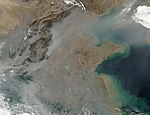Portal:Environment/Selected article/5
Global dimming is the gradual reduction in the amount of global direct irradiance at the Earth's surface that was observed for several decades after the start of systematic measurements in the 1950s. The effect varies by location, but worldwide it has been estimated to be of the order of a 4% reduction over the three decades from 1960–1990. However, after discounting an anomaly caused by the eruption of Mount Pinatubo in 1991, a very slight reversal in the overall trend has been observed.
It is thought to have been caused by an increase in particulates such as sulphate aerosols in the atmosphere due to human action. The switch from a "global dimming" trend to a "brightening" trend in 1990 happened just as global aerosol levels started to decline.
Global dimming has interfered with the hydrological cycle by reducing evaporation and may have reduced rainfall in some areas. Global dimming also creates a cooling effect that may have partially masked the effect of greenhouse gases on global warming. Deliberate manipulation of this dimming effect is now being considered as a geoengineering technique to reduce the impact of climate change.

